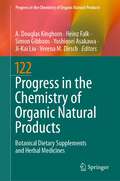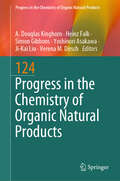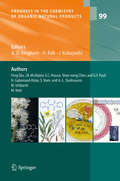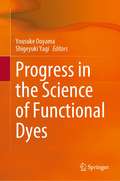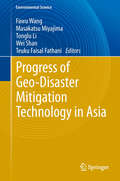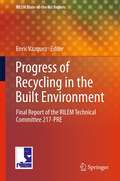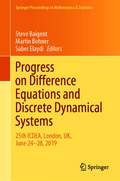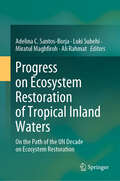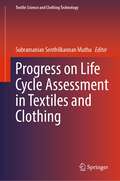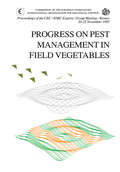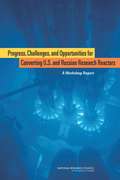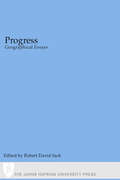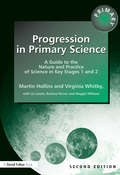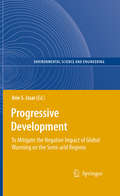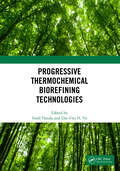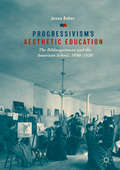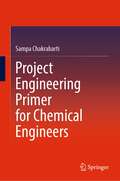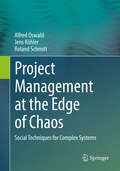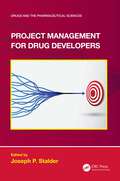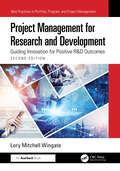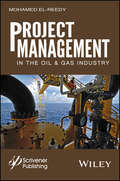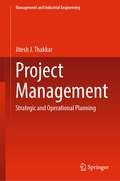- Table View
- List View
Progress in the Chemistry of Organic Natural Products 122: Botanical Dietary Supplements and Herbal Medicines (Progress in the Chemistry of Organic Natural Products #122)
by A. Douglas Kinghorn Heinz Falk Simon Gibbons Yoshinori Asakawa Ji-Kai Liu Verena M. DirschThis volume highlights some recent developments on plants used widely as botanical dietary supplements and herbal medicines, especially in terms of knowledge of the chemical types and diverse biological activities of their constituents, as well as laboratory approaches for their quality control and taxonomic identification. In the first chapter, the biologically active secondary metabolites are described of selected botanicals that have a wide current use in the United States, with recent information provided also on their in vitro and in vivo biological activities. The second chapter constitutes an updated survey of the different chromatographic, spectroscopic, and metabolomics techniques that can be utilized for the quality control of botanical products. The penultimate chapter covers different nomenclatural systems that are of use for the taxonomic identification of source plants used in botanical products. Finally, deoxyribonucleic acid molecular barcoding techniques for the identification for plants used as dietary supplements are covered.
Progress in the Chemistry of Organic Natural Products 124 (Progress in the Chemistry of Organic Natural Products #124)
by A. Douglas Kinghorn Heinz Falk Simon Gibbons Yoshinori Asakawa Ji-Kai Liu Verena M. DirschThis volume presents three chapters discussing a range of topics. Chapter 1 deals with the development of efficient methods for compound dereplication that have been critical in the re-emergence of research on natural products as a source of new drug leads. It describes the main methods of dereplication, which rely on the combined use of large natural product databases and spectral libraries, alongside the information obtained from chromatographic, UV-Vis, MS, and NMR spectroscopic analyses of the samples of interest. Chapter 2 describes 989 plant natural products and their ecological functions in plant-herbivore, plant-microorganism, and plant-plant interactions. These compounds include alkaloids, phenols, terpenoids, and other structural types. The information presented should provide the basis for in-depth research on these plant natural products and their natural functions, and also for their further development and utilization. Chapter 3 focuses on lichens, with each constituting a symbiotic association composed of a primary mycobiont and one or more photobionts living mutualistically. Covered are lichens and their bionts, taxonomic identification, and their chemical constituents as exemplified by what is found in lichen biomes, especially those endemic to North America. Extraction and isolation procedures, as well as updates on dereplication methods using mass spectrometric GNPS and NMR spectroscopic spin network fingerprint procedures, and marker-based techniques to identify lichens are discussed. The isolation and structure elucidation of secondary metabolites of an endolichenic Penicillium species that produces bioactive compounds is described in detail.
Progress in the Chemistry of Organic Natural Products 99
by A. Douglas Kinghorn H. Falk J. KobayashiThe volumes of this classic series, now referred to simply as "Zechmeister" after its founder, Laszlo Zechmeister, have appeared under the Springer Imprint ever since the series' inauguration in 1938. The series has featured contributions by seven Nobel laureates: D. H. R. Barton, D. Crowfoot Hodgkin, L. Pauling, K. Alder, O. Diels, P. Karrer, H. von Euler-Chelpin. The volumes contain contributions on various topics related to the origin, distribution, chemistry, synthesis, biochemistry, function or use of various classes of naturally occurring substances ranging from small molecules to biopolymers. Each contribution is written by a recognized authority in the field and provides a comprehensive and up-to-date review of the topic in question. Addressed to biologists, technologists, and chemists alike, the series can be used by the expert as a source of information and literature citations and by the non-expert as a means of orientation in a rapidly developing discipline.
Progress in the Chemistry of Organic Natural Products Vol. 94
by A. Douglas Kinghorn Heinz Falk Junichi KobayashiThe three reviews cover the advances in the chemistry and biology of withanolides over the last 16 years, review the chemistry and biology of the rocaglamide-type derivatives and related compounds, with emphasis on their structural diversity, biosynthesis, pharmacological significance and total synthesis, and summarize the extensive chemistry and biology studies on a natural product, which have resulted in a novel therapy approved worldwide.
Progress in the Science of Functional Dyes
by Yousuke Ooyama Shigeyuki YagiThis book covers a wide range of topics related to functional dyes, from synthesis and functionality to application. Making a survey of recent progress in functional dye chemistry, it provides an opportunity not only to understand the structure-property relationships of a variety of functional dyes but also to know how they are applied in practical use, from electronic devices to biochemical analyses. From classic dyes such as cyanines, squaraines, porphyrins, phthalocyanines, and others to the newest functional π-conjugation systems, various types of functional dyes are dealt with extensively in the book, focusing especially on the state of the art and the future. Readers will benefit greatly from the scientific context in which organic dyes and pigments are comprehensively explained on the basis of chemistry.
Progress of Geo-Disaster Mitigation Technology in Asia
by Tonglu Li Fawu Wang Wei Shan Masakatsu Miyajima Teuku Faisal FathaniThis book includes the recent 10-year achievement of geo-disaster mitigation by leading Asian scientists from Japan, China, Indonesia, Korea, Iran and Far East of Russia. Case studies on recent occurred geo-disasters in Asian region have been presented. The forming mechanics of hazards such as earthquake and landslide are deeply discussed, and the disaster mitigation technology for building and pipeline safety, landslide hazard assessment and risk management are introduced.
Progress of Recycling in the Built Environment
by Enric VázquezThis report is a useful tool for countries starting to recycle aggregates or construction and demolition waste. It contains the latest developments in this field, introduces a completely new approach to the procedure of proportioning concrete mixtures with recycled aggregate, references recent publications, opinions and discrepancies in relation to the durability of recycled concrete, such as freeze-thaw standards, studies of chloride penetration and diffusion, and sulfate attacks, the use of the fine fraction <4mm, quality assurance of concrete recycled aggregate, sustainability and recycling construction waste and global impact assessment of urban renewal based on sustainable recycling strategies for construction and demolition waste. This volume will be of interest to recyclers, researchers and consumers.
Progress on Difference Equations and Discrete Dynamical Systems: 25th ICDEA, London, UK, June 24–28, 2019 (Springer Proceedings in Mathematics & Statistics #341)
by Martin Bohner Saber Elaydi Steve BaigentThis book comprises selected papers of the 25th International Conference on Difference Equations and Applications, ICDEA 2019, held at UCL, London, UK, in June 2019. The volume details the latest research on difference equations and discrete dynamical systems, and their application to areas such as biology, economics, and the social sciences. Some chapters have a tutorial style and cover the history and more recent developments for a particular topic, such as chaos, bifurcation theory, monotone dynamics, and global stability. Other chapters cover the latest personal research contributions of the author(s) in their particular area of expertise and range from the more technical articles on abstract systems to those that discuss the application of difference equations to real-world problems. The book is of interest to both Ph.D. students and researchers alike who wish to keep abreast of the latest developments in difference equations and discrete dynamical systems.
Progress on Ecosystem Restoration of Tropical Inland Waters: On the Path of the UN Decade on Ecosystem Restoration
by Adelina C. Santos-Borja Luki Subehi Miratul Maghfiroh Ali RahmatThis book explores the current ecosystem status of tropical inland waters especially in Southeast Asia, the progress of ecosystem restoration in terms of current studies, technological interventions, policy recommendations, and stakeholder participation that gives due respect to traditional knowledge and cultural practices, and the challenges and opportunities of the restoration processes. The UN Decade on Ecosystem Restoration and the UN Environment Assembly’s Resolution on Sustainable Lake Management were the motive force in the publication of the book. Inland waters provide humans and a myriad of organisms with tremendous benefits. However, changing inland water environment due to external and internal pressures leads to unfortunate events such as water degradation, loss of biodiversity, and destruction of ecosystems with serious socio-economic consequences. This book serves as a good reference for students, academia, practitioners and other professionals, policy makers, and other stakeholders. The updated data and information on various aspects of ecosystem restoration, sustainable management, and utilization of inland waters contribute to understanding how ecosystem restoration of tropical inland water progresses in a changing environment. The book includes multidisciplinary and insightful information on tropical inland waters in line with the UN Decade of Ecosystem Restoration in 2021.
Progress on Life Cycle Assessment in Textiles and Clothing (Textile Science and Clothing Technology)
by Subramanian Senthilkannan MuthuTextiles and Clothing are key sectors and apparel is one of the necessities of human life. Environmental brunt of the textile sector and cradle to grave life cycle impacts of textiles and clothing products are a subject of constant investigation. There have been a lot of advancements in the textile sector in terms of materials such as textile fibres, yarns, fabrics, garments and also in terms of processes. All these innovations demand an environmental profile as well. Life Cycle Assessment is one of the widely used and popular scientific tools which has been utilized to measure the environmental footprints of various products and processes. This volume presents recent advances on LCA in the textiles and clothing sector.
Progress on Pest Management in Field Vegetables
by R. CavalloProceedings of the CEC/IOBC Expert's Group Meeting, Pennes, France, November 1985. Forty contributions (authors are from 12 countries and two international organizations) deal with crops such as cabbages, carrots, tomatoes, potatoes, beans, and artichokes and with the particularly urgent task of red
Progress, Challenges, and Opportunities for Converting U.S. and Russian Research Reactors
by Challenges U.S. Committee on Progress Opportunities for Converting U.S. Russian Reactors from Highly Enriched to Low Enriched Uranium FuelHighly enriched uranium (HEU) is used for two major civilian purposes: as fuel for research reactors and as targets for medical isotope production. This material can be dangerous in the wrong hands. Stolen or diverted HEU can be used-in conjunction with some knowledge of physics-to build nuclear explosive devices. Thus, the continued civilian use of HEU is of concern particularly because this material may not be uniformly well-protected. To address these concerns, the National Research Council (NRC) of the U. S. National Academies and the Russian Academy of Sciences (RAS) held a joint symposium on June 8-10, 2011. Progress, Challenges, and Opportunities for Converting U. S. and Russian Research Reactors summarizes the proceedings of this joint symposium. This report addresses: (1) recent progress on conversion of research reactors, with a focus on U. S. - and R. F. -origin reactors; (2) lessons learned for overcoming conversion challenges, increasing the effectiveness of research reactor use, and enabling new reactor missions; (3) future research reactor conversion plans, challenges, and opportunities; and (4) actions that could be taken by U. S. and Russian organizations to promote conversion. The agenda for the symposium is provided in Appendix A, biographical sketches of the committee members are provided in Appendix B, and the report concludes with the statement of task in Appendix C.
Progress: Geographical Essays
by Robert David Sack"The connection between geography and progress is fundamental," writes Robert Sack in the introduction to the present volume. Touching on both moral and material progress, six of the world's leading geographers and environmental historians explore differing aspects of this connection. Thomas Vale discusses whether progress is discernible in the natural realm; Kenneth Olwig examines fundamental changes that occurred to the notion of progress with the rise of modernity, while David Lowenthal and Yi-Fu Tuan discuss recent geographical changes that have resulted in an increasing societal disenchantment and anxiety. Nicholas Entrikin looks at progress as "moral perfectibility, and its connection to democratic places," a theme which Robert Sack further explores by prescribing ways in which geographers and citizens can evaluate and create places that increase our awareness of reality in its variety and complexity.Contributors: J. Nicholas Entrikin, University of California-Los Angeles; David Lowenthal, University College, London; Kenneth Olwig, University in Trondheim, Norway; Robert David Sack, University of Wisconsin-Madison; Yi-Fu Tuan, University of Wisconsin-Madison; Thomas R. Vale, University of Wisconsin-Madison.
Progression in Primary Science: A Guide to the Nature and Practice of Science in Key Stages 1 and 2
by Martin Hollins Maggie Williams Virginia WhitbyUsing many examples drawn from classroom practice, this guide supports and aims to extend the student teacher's own subject knowledge and understanding of science in the context of the primary classroom. It offers an accessible guide to all the main concepts of Key Stages one and two science teaching. Illustrating the importance of issues such as resourcing and assessing science in the primary classroom, the book offers guidance for practicing teachers who consider themselves "non-specialists" in science.
Progressive Development
by Arie S. IssarThe book is based on the results of the investigations of the authors in the semi-arid and arid regions (ASAR) of the globe. These investigations brought to the conclusion that the warming climate will cause the drying up of the water resources in these regions. In this case the principles of Sustainable Development will not be able to avert forthcoming catastrophes. These conclusions brought to the compilation of the policy of "Progressive Development", emphasising investment in the development of new water resources and changing the natural environments while advancing the local populations on the dimension of knowledge by education.
Progressive Thermochemical Biorefining Technologies
by Sonil Nanda; Dai-Viet N. VoConsidering the deleterious impacts of fossil fuels on the environmental and natural ecosystems, it has become imperative to make a paradigm shift toward renewable fuels, chemicals, and materials. The exhaustive everyday usage of fossil fuels and processed petrochemical products are the leading causes for the increase in greenhouse gas emissions, global warming, climate changes, acid rain, ozone layer depletion, pollution of air, water, and soil as well as for the accumulation of nonbiodegradable materials in the soil and oceans. On the contrary, biofuels, biochemicals, and biomaterials derived from renewable wastes such as nonedible plant biomass (e.g., agricultural and forestry biomass), energy crops, microalgae, municipal solid waste, sewage sludge, and other biogenic residues seem to be carbon neutral. Therefore, the global interest in biorefining technologies, especially thermochemical and biological conversion processes, is gaining momentum in academic and industrial perspectives. Progressive Thermochemical Biorefining Technologies offers all-inclusive coverage of the most crucial topics as follows: State-of-the-art information on the production and utilization of biofuels through thermochemical biorefining technologies Conversion of waste biomass through pyrolysis, liquefaction, torrefaction, carbonization, gasification, reforming, and other clean technologies Waste-to-energy/chemical generation Fuel upgrading technologies Techno-economic analysis and life-cycle assessment of biorefining processes Specifically designed to be instantly applicable, this volume serves as a reference book for undergraduate and graduate students, scientific investigators, and research scholars working in the areas relating to energy and fuels.
Progressivism's Aesthetic Education: The Bildungsroman and the American School, 1890–1920
by Jesse RaberDuring the Progressive Era in the United States, as teaching became professionalized and compulsory attendance laws were passed, the public school emerged as a cultural authority. What did accepting this authority mean for Americans’ conception of self-government and their freedom of thought? And what did it mean for the role of artists and intellectuals within democratic society? Jesse Raber argues that the bildungsroman negotiated this tension between democratic autonomy and cultural authority, reprising an old role for the genre in a new social and intellectual context. Considering novels by Abraham Cahan, Willa Cather, and Charlotte Perkins Gilman alongside the educational thought of John Dewey, the Montessorians, the American Herbartians, and the social efficiency educators, Raber traces the development of an aesthetics of social action. Richly sourced and vividly narrated, this book is a creative intervention in the fields of literary criticism, pragmatic philosophy, aesthetic theory, and the history of education.
Proinflammatory and Antiinflammatory Peptides (Lung Biology In Health And Disease Ser. #112)
by Sami I. Said"Analyzes the role of peptides in promoting or suppressing inflammation. Thoroughly examines the therapeutic potential of key peptides, analogs, agonists, and antagonists that influence cell injury and repair."
Project Based Inquiry Science: Vehicles in Motion
by Janet L. Kolodner Joseph S. Krajcik Daniel C. Edelson Brian J. Reiser Mary L. StarrProject-Based Science suggests that students should learn science through engaging in the same kinds of inquiry practices scientists use, in the context of scientific problems relevant to their lives and using tools authentic to science.
Project Engineering Primer for Chemical Engineers
by Sampa ChakrabartiThis book discusses financial, managerial and engineering aspects associated with project engineering. The book is a text/reference book on courses related to project engineering for undergraduate students of Chemical Engineering programmes. The author has utilized her decade-long professional experience with reputed project consultancy organizations and her academic experience in writing this book. The background of project engineering is described with special emphasis on its interdisciplinary nature. Project management techniques are discussed with the help of worked-out examples. It includes multiple choice questions and information regarding relevant courses in different institutes. The book is useful for undergraduate degree and diploma students as well as for fresh graduate engineering trainees in various process consulting organizations.
Project Management at the Edge of Chaos: Social Techniques For Complex Systems
by Jens Köhler Alfred Oswald Roland SchmittComplexity is a gift that can be made available for the successful implementation of projects, and used to create a new order or to change an existing one. Based on scientific facts, the authors present a systematic approach, which integrates complexity and its multitude of facets and gives practical recommendations for dealing with complexity in projects. The methods paradigm in project management is currently undergoing a massive upheaval. Projects are complex entities that cannot be tackled using traditional methods, such as classical cause and effect approaches. Complexity, and the associated phenomenon of self-organization, is a natural, but hidden designer. It offers a great opportunity in its use as a key driver for the implementation of projects. This requires identification of the principles of complexity and then using these for project management. In this book, the latest findings from natural sciences and brain research are used and transferred within a practice-oriented framework. The authors describe the methods of complexity regulation in projects and how self-organization for the management of projects can be applied.
Project Management for Drug Developers (Drugs and the Pharmaceutical Sciences)
by Joseph P. StalderProject managers in drug development are the driving force behind the coordination of efforts. This book provides a practical reference for project managers in the pharmaceutical and biotech drug development industry, with the goal of assisting in creating an efficient and effective team structure and environment. The text details the role of project managers at each stage of drug development, the key interfaces that the PM will need to work closely with, and essential tools of the trade including frequently used techniques and methodologies. This book is useful for both entry-level and advanced-level PMs, as well as non-project managers from other functions. Features Includes authors' recent experience with improved tactics and technologies/software at various stages of drug development. Provides the most up-to-date and best practices, techniques, and methodologies in project management. Details the role of the PM at each stage of drug development, including working with the key interfaces throughout the process. Diverse audience including nonproject managers in clinical development, clinical operations, regulatory affairs, medical affairs, clinical pharmacology, and biostatistics. Provides templates and timelines for critical paths from development to commercialization and has potential as a textbook on relevant courses.
Project Management for Research and Development: Guiding Innovation for Positive R&D Outcomes (Best Practices in Portfolio, Program, and Project Management)
by Lory Mitchell WingateResearch and development (R&D) activities do not fit the traditional project model. They may seem difficult to manage because of their inherent ambiguity, the need for creative exploration, and often the lack of having defined milestones and outcomes. However, project management methods, along with systems engineering as a complementary discipline, provide the ability to categorize R&D activities, bound them, and then assess progress along a defined course of action. They also provide information about status and progress, visibility into opportunities and challenges that might otherwise be missed, allowing timely course corrections.Project Management for Research and Development: Guiding Innovation for Positive R&D Outcomes, Second Edition, provides methods for optimizing results in R&D by using structured processes that come from project management and are intertwined with the key complementary discipline of systems engineering. It provides processes, tools, and techniques to assess and manage creative activities in an optimal way. The core of the book is a flexible framework, which lifts the burden off organizations that do not want to invest heavily in implementing a significant number of often conflicting processes. It is a lightweight, flexible structure to help organizations and individuals meet their most important goals, no matter how complicated or complex these goals may be.Each chapter in the book includes Apply Now exercises, which allow immediate application of fundamental concepts, summarizes key points of concepts and terms, and provides templates to apply the ideas from each chapter to a real-life situation. The book also features unique and creative case studies to demonstrate the application of project management to various R&D projects.
Project Management in the Oil and Gas Industry
by Mohamed A. El-ReedyOil and gas projects have special characteristics that need a different technique in project management. The development of any country depends on the development of the energy reserve through investing in oil and gas projects through onshore and offshore exploration, drilling, and increasing facility capacities. Therefore, these projects need a sort of management match with their characteristics, and project management is the main tool to achieving a successful project. Written by a veteran project manager who has specialized in oil and gas projects for years, this book focuses on using practical tools and methods that are widely and successfully used in project management for oil and gas projects. Most engineers study all subjects, but focus on project management in housing projects, administration projects, and commercial buildings or other similar projects. However, oil and gas projects have their own requirements and characteristics in management from the owners, engineering offices, and contractors' side. Not only useful to graduating engineers, new hires, and students, this volume is also an invaluable addition to any veteran project manager's library as a reference or a helpful go-to guide. Also meant to be a refresher for practicing engineers, it covers all of the project management subjects from an industrial point of view specifically for petroleum projects, making it the perfect desktop manual. Not just for project managers and students, this book is helpful to any engineering discipline or staff in sharing or applying the work of a petroleum project and is a must-have for anyone working in this industry.
Project Management: Strategic and Operational Planning (Management and Industrial Engineering)
by Jitesh J. ThakkarThis volume discusses strategic and operational issues in executing projects. It provides both quantitative and qualitative treatment on key areas of project management, and addresses issues of scheduling, procurement, quality, risk and communications management. The beneficiaries of this volume will primarily be university students in Engineering and Business Management disciplines. The book also extends practical insights and will be useful to professionals working in manufacturing and service industries.
